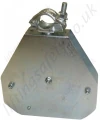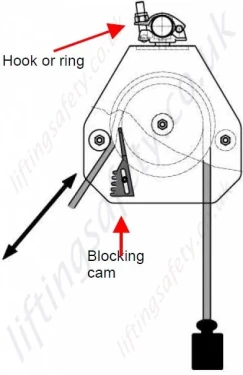-
Lifting Equipment

Lifting Equipment
- Chain Hoists
-
Wire Rope Hoists & Winches
- Hand Operated Wire Rope Winches and Hoists
- Cable Pullers / Hoists, Wire Rope Manual Operation
- Electric Winches and Hoists, AC (Mains Powered)
- Scaffold Hoists & Accessories
- Overhead Wire Rope Crane Hoists
- Hydraulic Wire Rope Winches & Hoists
- Pneumatic Wire Rope Air Winches / Hoists (Lifting and Pulling)
- Vehicle Mounted Winches
- Tractel Wire Rope & Accessories
-
General Lifting Equipment
- Soft Lifting Slings
- Lifting Chain Slings
- Wire Rope Slings & Assemblies
- Lifting Shackles
- Eye Bolts and Nuts
- Weld-on Lifting Eyes and Lashing Points
- Lifting & Pulling Clamps
- Lifting Beams & Spreader Beams
- Precast Concrete Lifting
- Lifting Magnets, Permanent, Battery Electric and Manual
- Beam Trolleys and Crane Bridges, Push, Geared & Electric
- Equipment Identification Tags
-
Rigging Equipment
- Master Ring & Load Suspension Eyes
- Lifting & Rigging Hooks
- Turnbuckles & Rigging Screws
- Wire Rope Accessories and Fittings
- Snatch Blocks, Sheave Blocks and Crane Pulley Blocks
- Pulley Sheaves
- Lifting & Rigging Swivels - Eye, Hook & Shackle
- Load Restraint Equipment
- General Rigging Accessories
- Crosby Lifting & Rigging
-
Cranes & Gantry Systems
- Portable Davit Arms
- Swing Jib Cranes - Installed Floor & Wall Cranes
- Portable/Mobile Free-standing Swing Jib Cranes
- Aluminium Gantry Cranes
- Steel Gantry Cranes
- Fixed Steel Gantry Systems
- Shearlegs, Tripods & Quadpods
- Overhead Crane Systems
- Portable Shop-Floor/Workshop/Garage Cranes
- Counterbalance Floor, Workshop Cranes
- Scaffolding Runway Beam Systems
-
Material Handling & Jacking Equipment
- Machinery & Load Moving Skates
- Hydraulic Cylinders & Pumps
- Lifting Jacks
- Manhole Cover Lifters
- Hydraulic Pull Cylinders
- Hand Operated Pallet Trucks, Pump Trucks
- Stacker Trucks, Materials Lifts, Manual and Electric
- Genie and Counterbalance Materials Lifters
- Scissor Lift Tables
- Drum Handling Equipment
- Crane Forks
- Load Weighing Equipment - Load Cells
- Tool Spring Balancers / Load Balancers
- Platform Trucks & Trolleys
-
Forklift Truck Attachment
- Fork Mounted Man Riding Baskets
- Environment & Waste Handling Attachments
- Fork Lift Truck Mounted Drum Handling Attachments
- Fork Mounted Jib and Hook Attachments
- Fork Truck Booms & Tines
- Stainless Steel Forklift Attachments
- Forklift Truck Fork Extensions
- Multi Fork Attachments
- Fork Truck Scoop Attachments
- Big Bag Fork Truck Attachment
- Closed Base Coil Support Attachments
- Forklift Fork Protection Sleeves
- Snow Plough Fork Lift Truck Attachments
- Other Forklift Truck & Telehandler Attachments
- Specialist Lifting Equipment
- Access and Safety Related
- Workshop and Shop Floor
- Screwjacks & Actuators
-
Height Safety

Height Safety Equipment
-
Fall Arrest and Height Safety Harnesses
- General Use Harnesses EN361
- Work Positioning Harnesses EN361 & EN358
- Rope Access Harnesses
- Rescue Harnesses EN1497 & EN361
- Ladies & Childrens Harnesses
- Hi Vis Jacket/Vest Harnesses
- Welders Harnesses
- ATEX (Anti-Static) Harnesses
- Linesman Harnesses
- Oil Derrick Harnesses
- Sport Climbing Harnesses
- Tree Surgeon Positioning Harnesses
- Sit and Chest Harnesses. EN361 EN356 & EN831
- Work Positioning & Restraint Belts EN358
- Fall Arrest, Restraint and Positioning Lanyards
- Height Safety and Fall Arrest Kits
- Inertia Reels and Retrieval Blocks
-
Confined Space and Rescue Systems
- Xtirpa Confined Space Davit Arm Systems and Components
- Sala Advanced Davit Arm Systems and Components
- Genesi Confined Space Systems
- Abtech Man-riding, Fall Arrest and Rescue Davits and Components
- Man-riding Hoists & Rescue Winches
- Fall Arrest & Rescue Tripods
- Fall Arrest Davit Arms & Posts for Working at Height
-
Fall Arrest & Man-riding Systems
- Manriding Systems, Baskets and Chairs
- Mobile Fall Arrest Gantries, Systems & Steps
- Rope Guided Fall Arresters (Steel & Synthetic Rope)
- Temporary Horizontal Fall Arrest Lifelines
- Vertical Fall Arrest Systems Permanently Installed
- Horizontal Fall Arrest Systems Permanently Installed
- Manriding Baskets Fork Truck and Overhead Crane
- Tank Side Entry and Vehicle Fall Arrest Systems
- Suspension Seats / Bosuns Chair Working at Height
- Collective Fall Arrest Systems
- Man-Riding Sheave Blocks
- Anchorage Devices
- Karabiners & Connectors
- Rescue, Evacuation & Rope Access
-
General Height Safety Gear
- Height Safety Accessories
- Industrial & Climbing Height Safety Helmets
- Synthetic Height Safety Rope & Anchorage Lines
- Height safety Pulley Wheels For Synthetic & Steel Wire Rope
- Black Height Safety Equipment & PPE
- Hot Work Equipment. Cutting, Grinding & Welding
- Cases, Bags, Backpacks, Holdalls. Height Safety Gear
- Telescopic Extension Pole for Height Safety Applications
- Wind Energy Height Safety Equipment
- Stainless Steel Fall Arrest Equipment
-
Fall Arrest and Height Safety Harnesses
- Home
- About Us
-
Contact
Get In Touch
- Home/
- Lifting Equipment/
- Rigging Gear; Riggers Lifting Equipment/
- Snatch Blocks, Sheave Blocks and Crane Pulley Blocks/
- Other Lifting Pulley Wheels/
- Tractel "Poulistop" Builders Gin Wheel with Brake - 50kg Capacity
Tractel "Poulistop" Builders Gin Wheel with Brake - 50kg Capacity
Manual safety pulley system with brake designed for temporary lifting installations on construction sites.
Poulistop 2 / TBGW-4445







The Poulistop has an integrated braking system which allows you, the user, to effortlessly lift up to a capacity of 50kg. The Poulistop offers iteself as a safer and more secure alternative to a Gin Wheel.
POULISTOP2 is designed for temporary lifting installations on construction sites. It is designed for manual lifting up to 50 kg WLL (load + rope), and is to be used with a braided nylon rope (Ø 18 to 20 mm) for lifting heights up to 30 meters. It iss equipped with its own unique rope blocking system using a sliding plastic brake, lockable and unlockable by the remote user by acting on the rope. It is then possible for the user to maintain the load in suspension without any effort.
Built with a zinc coated steel structure and a polymere sheave and brake. This in order to prevent from corrosion. The pulley weighs only 4 kgs (without the rope) for manipulations without difficulties. The braided nylon rope has a diameter of 18-20 mm
The rope’s blocking is ensured by a striated brake which slides along a vertical axis and acts by wedging on the rope against a metal axis.
The load applied to the rope tends to take up the slack side of the rope. When the slack side of the rope is vertical, it involves with him the brake, which then exerts an effort of wedging on the rope, which locks in position. So the resisting force of the rope is directly proportional to the load.
In order to free the rope, the operator has to apply to the slack side of the rope an angle of 15°approximately. Then the brake will be released.
The POULISTOP 2 is a non-opening pulley therefore the rope has to be introduced between the flanges by guiding it. The height of the flanges is important and permits a simple installation of the rope.
Features and Specifications
- Available with two suspension options: hook suspended or scaffold clamp (ring) for fixing to scaffold arm accessory.
- Complies to CE 2006/42
- All components are corrosion resistant
- The rope supplied with (if opted for) is manfuctured from nylon which is resistant to water and rotproof
- 18mm rope (optional) is supplied in 50m lengths
- Scaffold arm attachment is available as an optional extra
- Maintenance is easy as no greasing is required and the unit can be easily cleaned with water
- The ultimate load is 4 times the working load limit
- Weighs approximately 4kg (pulley only)
- Maximum acceptable load : 50 kg (including weight of the rope of about 0,3kg/m)
How it works
The Poulistop rope blocking system works by a brake which slides along a vertical axis and acts by wedging on the rope against a metal axis. When the slack side of the rope is vertical, it engages the brake, which then exerts an effort of wedging on the rope, which locks in position. So the resisting force of the rope is directly proportional to the load. In order to free the rope the operator has to apply a 15° angle to release the brake.
Additional Information
The effectiveness of blocking is guaranteed by the contact between the rope and the brake. Consequently, these two elements must be the subject of a routine inspection, and be replaced if necessary. In any event, the installation of a new rope must be accompanied by the replacement of the brake.
The blocking of the load enables the operator to stop the movement of rise or descent by ensuring them resumption of the load.
This is only for assisting the operator, it is not allowed to leave the load in suspension without monitoring.
The rope’s blocking must always be engaged before releasing the slack side of the rope: if not, during a operation (voluntary or not), the brake will function (provided that the slack side can be repositioned vertically) but the stopping distance of the load can strongly vary according to the conditions of use, and in addition an accelerated wear of the components of blocking (cam, cord) is to regret.
The POULISTOP 2 brake has to be free from grease and has to rotate freely. This piece has to be cleaned regularly. We advise not to use the POULISTOP 2 at temperatures below zero degrees.
Always ensure that the mechanical resistance of anchorage point of a POULISTOP 2 accept at least 108 kg.
- NEVER USE FOR PERSONNEL LIFTING
- The operator is not authorised to release the rope or leave equipments out of control when a load is hanged up on a pulley.
- Strictly forbidden to either be under or to walk under the load.
- Always use suitable rope (size, length and capacity)
- Always suspend the load on the indicated side (see marking on pulley)
- The pulley should be regularly inspected (priory checking : parts correctly assembled, no excessive movement, no excessive wearing or corrosion, no deformation, free rotating sheave)
- Never use a pulley with a hook as head fitting without ensuring that the safety latch is correctly operated and free from deformation.
- For lifting operations, the user must refer to the safety rules and regulations applicable to this use
- Never install POULISTOP 2 as a return pulley

Pricing
The Poulistop has an integrated braking system which allows you, the user, to effortlessly lift up to a capacity of 50kg. The Poulistop offers iteself as a safer and more secure alternative to a Gin Wheel.
POULISTOP2 is designed for temporary lifting installations on construction sites. It is designed for manual lifting up to 50 kg WLL (load + rope), and is to be used with a braided nylon rope (Ø 18 to 20 mm) for lifting heights up to 30 meters. It iss equipped with its own unique rope blocking system using a sliding plastic brake, lockable and unlockable by the remote user by acting on the rope. It is then possible for the user to maintain the load in suspension without any effort.
Built with a zinc coated steel structure and a polymere sheave and brake. This in order to prevent from corrosion. The pulley weighs only 4 kgs (without the rope) for manipulations without difficulties. The braided nylon rope has a diameter of 18-20 mm
The rope’s blocking is ensured by a striated brake which slides along a vertical axis and acts by wedging on the rope against a metal axis.
The load applied to the rope tends to take up the slack side of the rope. When the slack side of the rope is vertical, it involves with him the brake, which then exerts an effort of wedging on the rope, which locks in position. So the resisting force of the rope is directly proportional to the load.
In order to free the rope, the operator has to apply to the slack side of the rope an angle of 15°approximately. Then the brake will be released.
The POULISTOP 2 is a non-opening pulley therefore the rope has to be introduced between the flanges by guiding it. The height of the flanges is important and permits a simple installation of the rope.
Features and Specifications
- Available with two suspension options: hook suspended or scaffold clamp (ring) for fixing to scaffold arm accessory.
- Complies to CE 2006/42
- All components are corrosion resistant
- The rope supplied with (if opted for) is manfuctured from nylon which is resistant to water and rotproof
- 18mm rope (optional) is supplied in 50m lengths
- Scaffold arm attachment is available as an optional extra
- Maintenance is easy as no greasing is required and the unit can be easily cleaned with water
- The ultimate load is 4 times the working load limit
- Weighs approximately 4kg (pulley only)
- Maximum acceptable load : 50 kg (including weight of the rope of about 0,3kg/m)
How it works
The Poulistop rope blocking system works by a brake which slides along a vertical axis and acts by wedging on the rope against a metal axis. When the slack side of the rope is vertical, it engages the brake, which then exerts an effort of wedging on the rope, which locks in position. So the resisting force of the rope is directly proportional to the load. In order to free the rope the operator has to apply a 15° angle to release the brake.
Additional Information
The effectiveness of blocking is guaranteed by the contact between the rope and the brake. Consequently, these two elements must be the subject of a routine inspection, and be replaced if necessary. In any event, the installation of a new rope must be accompanied by the replacement of the brake.
The blocking of the load enables the operator to stop the movement of rise or descent by ensuring them resumption of the load.
This is only for assisting the operator, it is not allowed to leave the load in suspension without monitoring.
The rope’s blocking must always be engaged before releasing the slack side of the rope: if not, during a operation (voluntary or not), the brake will function (provided that the slack side can be repositioned vertically) but the stopping distance of the load can strongly vary according to the conditions of use, and in addition an accelerated wear of the components of blocking (cam, cord) is to regret.
The POULISTOP 2 brake has to be free from grease and has to rotate freely. This piece has to be cleaned regularly. We advise not to use the POULISTOP 2 at temperatures below zero degrees.
Always ensure that the mechanical resistance of anchorage point of a POULISTOP 2 accept at least 108 kg.
- NEVER USE FOR PERSONNEL LIFTING
- The operator is not authorised to release the rope or leave equipments out of control when a load is hanged up on a pulley.
- Strictly forbidden to either be under or to walk under the load.
- Always use suitable rope (size, length and capacity)
- Always suspend the load on the indicated side (see marking on pulley)
- The pulley should be regularly inspected (priory checking : parts correctly assembled, no excessive movement, no excessive wearing or corrosion, no deformation, free rotating sheave)
- Never use a pulley with a hook as head fitting without ensuring that the safety latch is correctly operated and free from deformation.
- For lifting operations, the user must refer to the safety rules and regulations applicable to this use
- Never install POULISTOP 2 as a return pulley

You May Also Like
Contact Us About This Product
If you wish to receive a quote for this product, please use the tab above, this form is for general enquiries regarding this product only.
You can also Request a Quote using the Quote tab above!
You can easily add more than one item to the Quote Request. This is highly recommended as we will be able to suit your needs much more efficiently.






